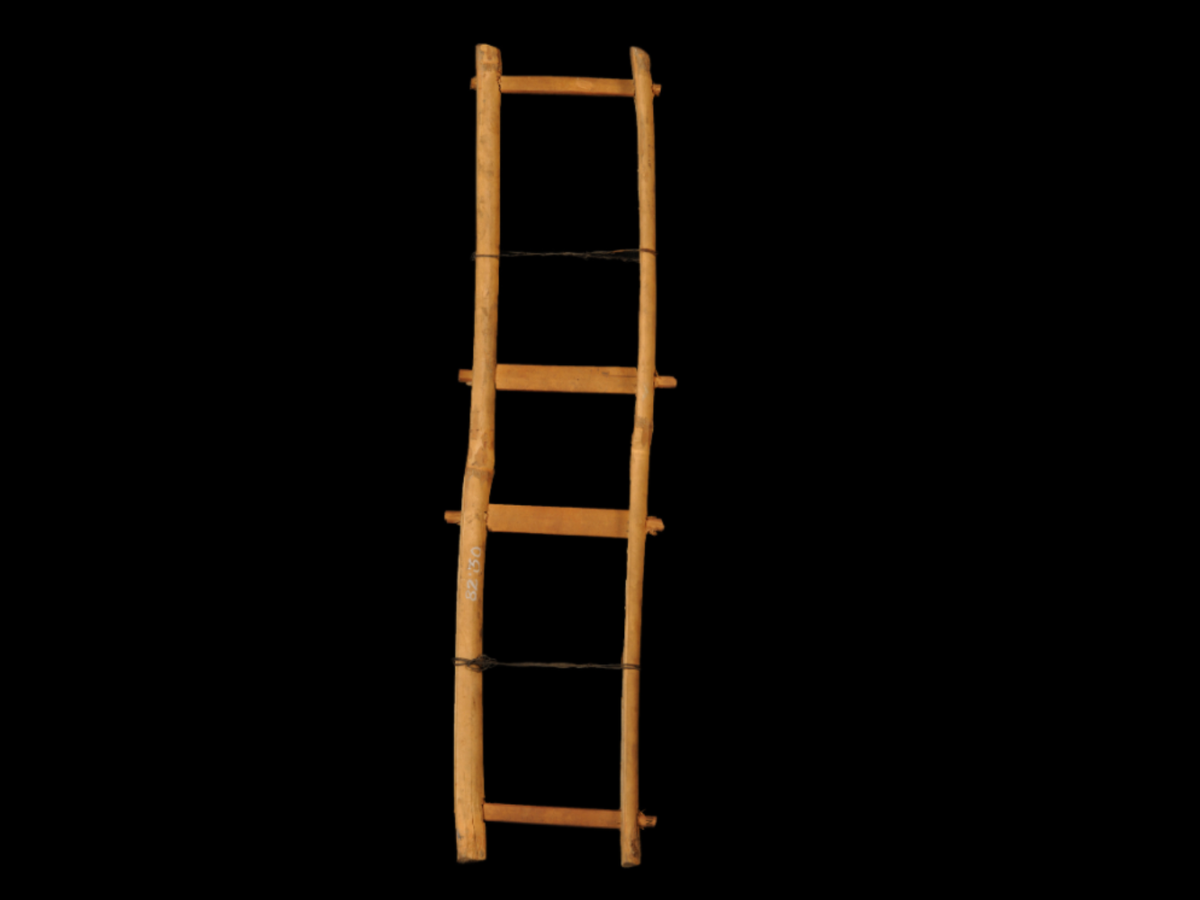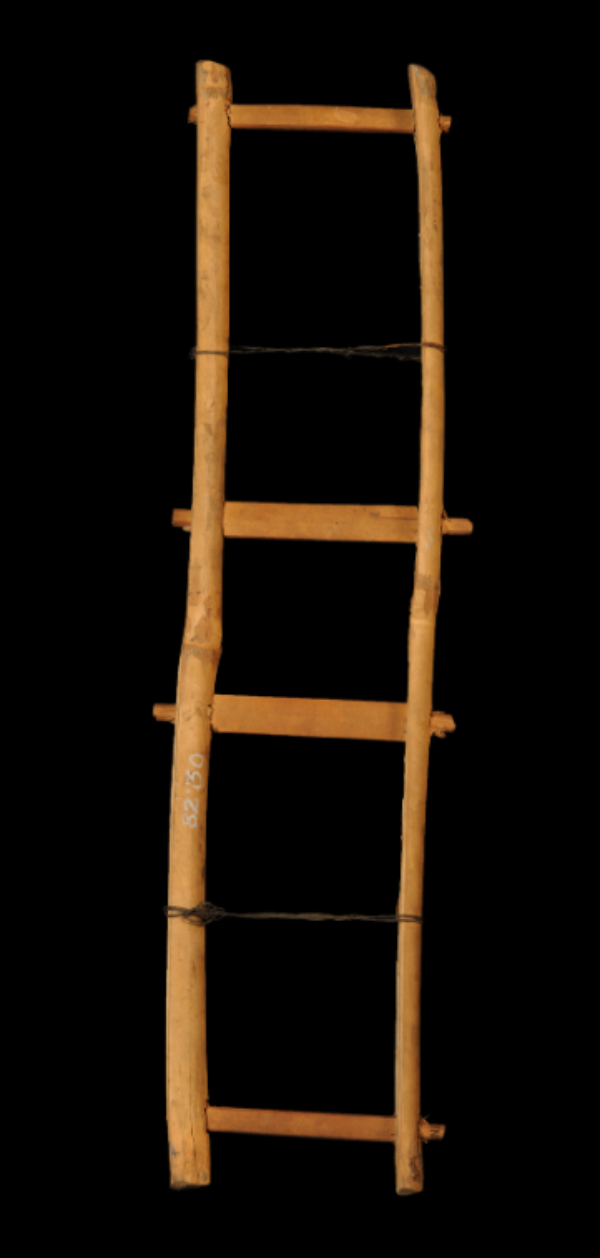State
Tribe Name
Art Type
short description
The Rabha tribe is an ancient community and more prominent in Assam, Meghalaya, and West Bengal. The people are well-known for their tradition in craftsmanship and their thick bonding with nature. Bamboo finds its place in this life; it finds a definite use in the construction of houses, tools, and household things. It includes a bamboo ladder necessary for many activities.
The bamboo ladders were constructed using two long splits of bamboo placed parallel to each other, and within them four smaller thinner splits to serve the purpose of rungs. It's simple structure that belies its strength and provides a lightweight climbing tool that is also quite sturdy. The ladders are used by the Rabha people to harvest fruits from trees, to reach places on top of their stilts houses (Elwin, 1950).
The bamboo ladder serves other purposes in addition to its practical existence; it also serves quite important socio-cultural functions in the Rabha community. The ladder finds use during construction houses, for some periods, while performing farming operations, and as well as in a few religious ceremonies, symbolizing "resourcefulness" and "sustainability" (Das, 2015). Firm believers of using natural resources wisely, the Rabha people proudly feature their adeptness in bamboo craftsmanship as holistically integrated with nature.
Modernity has not brought about any change in manufacture and use of such ladders, and, therefore, much of the inherited wisdom and artistry is preserved within the Rabha community. With this very simple tool they have represented their wisdom, adaptability, and ecology with respect to lifestyle so that their cultural heritage remains alive.
The bamboo ladders were constructed using two long splits of bamboo placed parallel to each other, and within them four smaller thinner splits to serve the purpose of rungs. It's simple structure that belies its strength and provides a lightweight climbing tool that is also quite sturdy. The ladders are used by the Rabha people to harvest fruits from trees, to reach places on top of their stilts houses (Elwin, 1950).
The bamboo ladder serves other purposes in addition to its practical existence; it also serves quite important socio-cultural functions in the Rabha community. The ladder finds use during construction houses, for some periods, while performing farming operations, and as well as in a few religious ceremonies, symbolizing "resourcefulness" and "sustainability" (Das, 2015). Firm believers of using natural resources wisely, the Rabha people proudly feature their adeptness in bamboo craftsmanship as holistically integrated with nature.
Modernity has not brought about any change in manufacture and use of such ladders, and, therefore, much of the inherited wisdom and artistry is preserved within the Rabha community. With this very simple tool they have represented their wisdom, adaptability, and ecology with respect to lifestyle so that their cultural heritage remains alive.
Thumbnail

Filter Postion
Left
Filter Background
Off
Theme
Filter Header Image

content
Image

description
The Rabha tribe is an ancient community and more prominent in Assam, Meghalaya, and West Bengal. The people are well-known for their tradition in craftsmanship and their thick bonding with nature. Bamboo finds its place in this life; it finds a definite use in the construction of houses, tools, and household things. It includes a bamboo ladder necessary for many activities.
The bamboo ladders were constructed using two long splits of bamboo placed parallel to each other, and within them four smaller thinner splits to serve the purpose of rungs. It's simple structure that belies its strength and provides a lightweight climbing tool that is also quite sturdy. The ladders are used by the Rabha people to harvest fruits from trees, to reach places on top of their stilts houses (Elwin, 1950).
The bamboo ladder serves other purposes in addition to its practical existence; it also serves quite important socio-cultural functions in the Rabha community. The ladder finds use during construction houses, for some periods, while performing farming operations, and as well as in a few religious ceremonies, symbolizing "resourcefulness" and "sustainability" (Das, 2015). Firm believers of using natural resources wisely, the Rabha people proudly feature their adeptness in bamboo craftsmanship as holistically integrated with nature.
Modernity has not brought about any change in manufacture and use of such ladders, and, therefore, much of the inherited wisdom and artistry is preserved within the Rabha community. With this very simple tool they have represented their wisdom, adaptability, and ecology with respect to lifestyle so that their cultural heritage remains alive.
The bamboo ladders were constructed using two long splits of bamboo placed parallel to each other, and within them four smaller thinner splits to serve the purpose of rungs. It's simple structure that belies its strength and provides a lightweight climbing tool that is also quite sturdy. The ladders are used by the Rabha people to harvest fruits from trees, to reach places on top of their stilts houses (Elwin, 1950).
The bamboo ladder serves other purposes in addition to its practical existence; it also serves quite important socio-cultural functions in the Rabha community. The ladder finds use during construction houses, for some periods, while performing farming operations, and as well as in a few religious ceremonies, symbolizing "resourcefulness" and "sustainability" (Das, 2015). Firm believers of using natural resources wisely, the Rabha people proudly feature their adeptness in bamboo craftsmanship as holistically integrated with nature.
Modernity has not brought about any change in manufacture and use of such ladders, and, therefore, much of the inherited wisdom and artistry is preserved within the Rabha community. With this very simple tool they have represented their wisdom, adaptability, and ecology with respect to lifestyle so that their cultural heritage remains alive.
Image Mode
portrait
promoted
Off
Verified
Off
